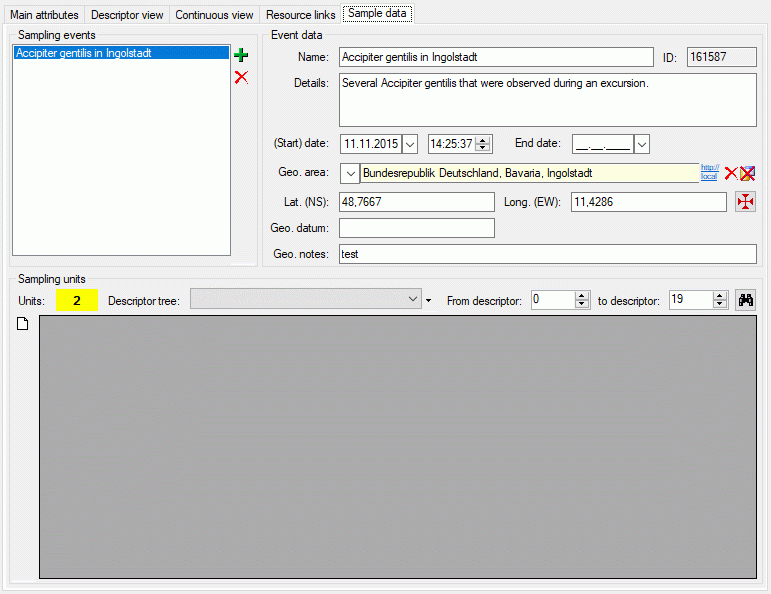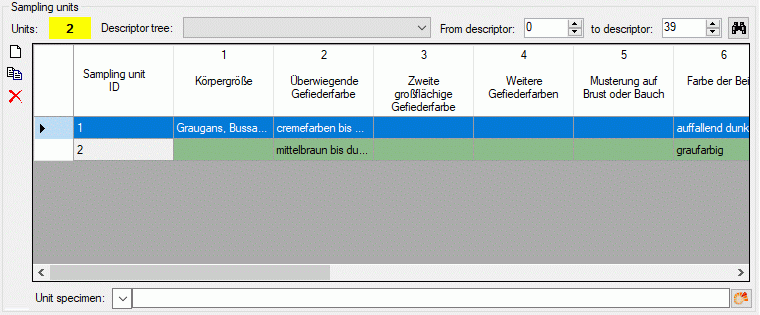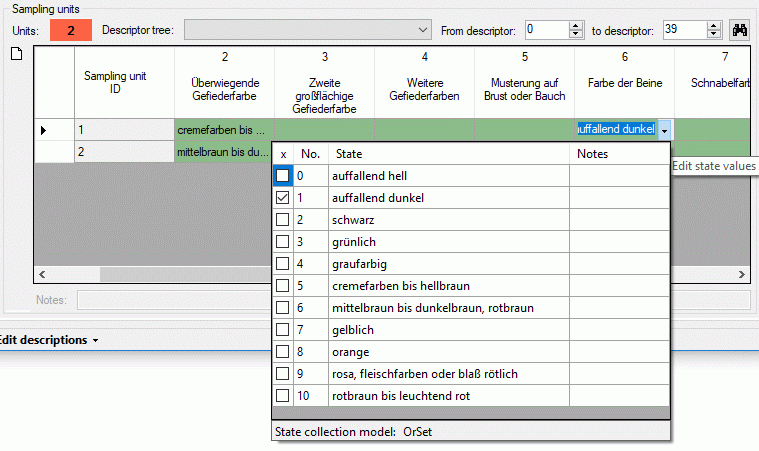Edit Description
Sample data

The sample data tab allows assigment and inspection of sampling events
and associated sampling units for the description. In the upper left
Sampling events part of the tab there is a list of the sampling
events stored for the description. By selecting a sampling event entry
the Event data are shown in the upper right part of the tab. Here
you may edit the event name, a detailled description, the date and time
rsp. a date and time span and geographic data. To insert a new sampling
event click on the 
 button (see image above).
button (see image above).
The geographic area may be linked to an entry of a DiversityGazetteers
database (see section Module related entry).
If latitiude and longituede have not yet been entered, the coordinates
of the selected DiversityGazetteers entry will be inserted. By pressing
the  button a window to select the
coordinates by Google maps will be opened. Field Geo. datum allows
entering short text concerning the geodetic datum. If coordinates are
entered using Google maps a remark that WGS84 coordinates are used will
be inserted.
button a window to select the
coordinates by Google maps will be opened. Field Geo. datum allows
entering short text concerning the geodetic datum. If coordinates are
entered using Google maps a remark that WGS84 coordinates are used will
be inserted.
Editing sampling unit data
For each sampling events one or several Sampling units may be entered. A sampling unit represents a tuple of values that belong together, e.g. because they represent a single specimen. For each descriptor, which is represented by the table column, a value may be entered in a sampling unit, which builds a single table line. The background colour of each table column indicates the type of sample data: categorical, quantitative, text or sequence . If the number of sampling units is displayed in field Units of the Sampling units section in the lower part of the tab. If sampling units are present, the number is displayed with yellow background (see image below).
To view the unit data, select a Descriptor tree and choose the
descriptor sequence range (From descriptor … to descriptor) to
restrict the number of columns displayed in the unit table. Finally
press button 

To insert a new sampling unit press button 



When you select the Sampling unit ID cell you may enter a collection
specimen in the Unit specimen control below the units table. By
clicking the 

To modify categorical sampling data enter the table cell and press the
 button within the cell. A control will be
opened where you can select the categorical states and enter notes or
modifier values (if defined) for each single state (see image below).
button within the cell. A control will be
opened where you can select the categorical states and enter notes or
modifier values (if defined) for each single state (see image below).

For all other sampling data the value can be entered directly in the
table cell. Notes for the selected table cell are entered in the
Notes: text box directly below the units table. For categorical,
text and molecular sequence sample data a separate edit window can be
opened by double-clicking the table cell. For molecular sequence data
the tool strip buttons  (import) and
(import) and
 (export) allow import and export from rsp. to
dedicated file formats as described in sections Import sequencedata and Export sequence
data.
(export) allow import and export from rsp. to
dedicated file formats as described in sections Import sequencedata and Export sequence
data.
Continue with:
- Edit descriptions - Main attributes tab
- Edit descriptions - Descriptor view tab
- Edit descriptions - Molecular sequence symbols
- Edit descriptions - Import sequence data
- Edit descriptions - Export sequence data
- Edit descriptions - Continuous view tab
- Edit descriptions - Resource links tab